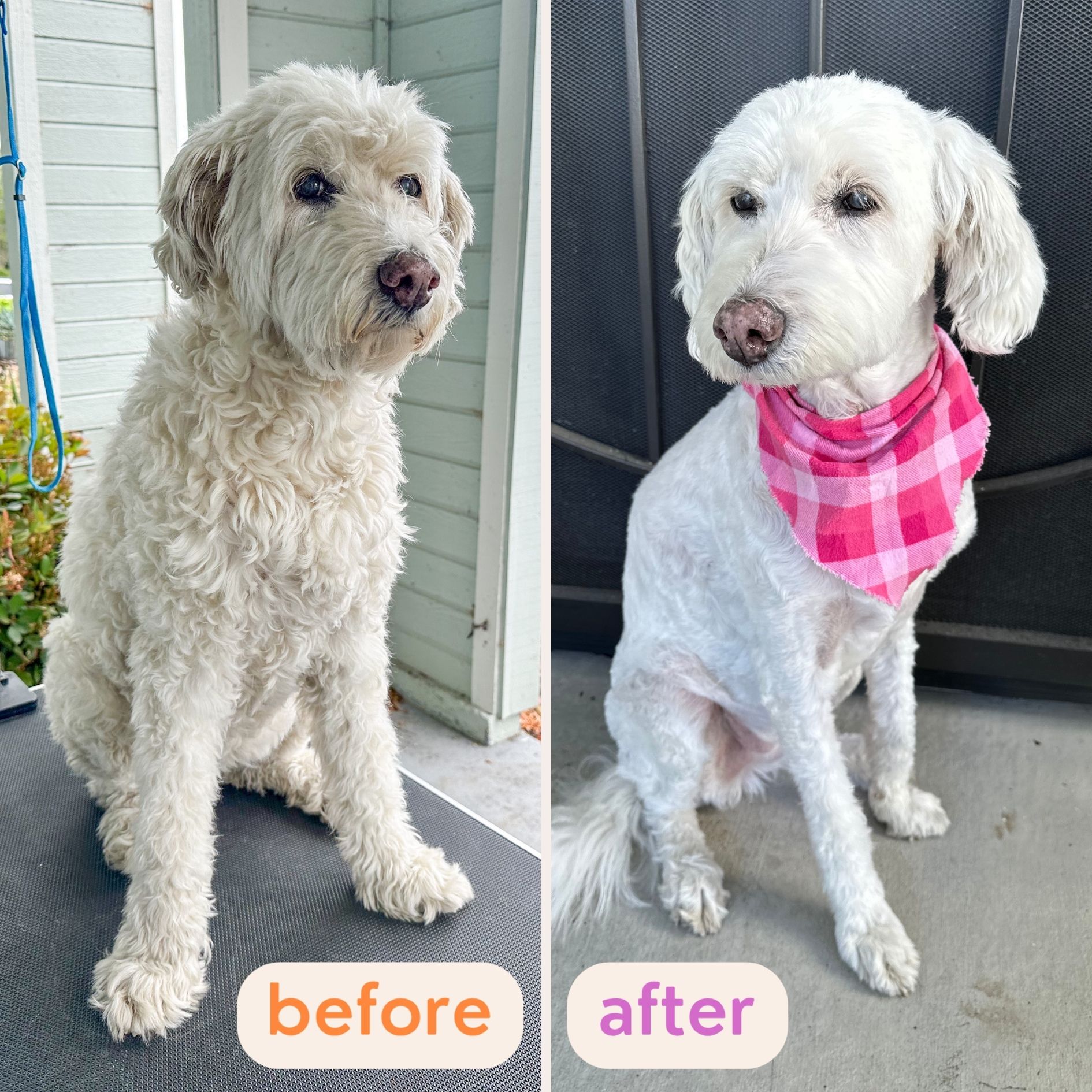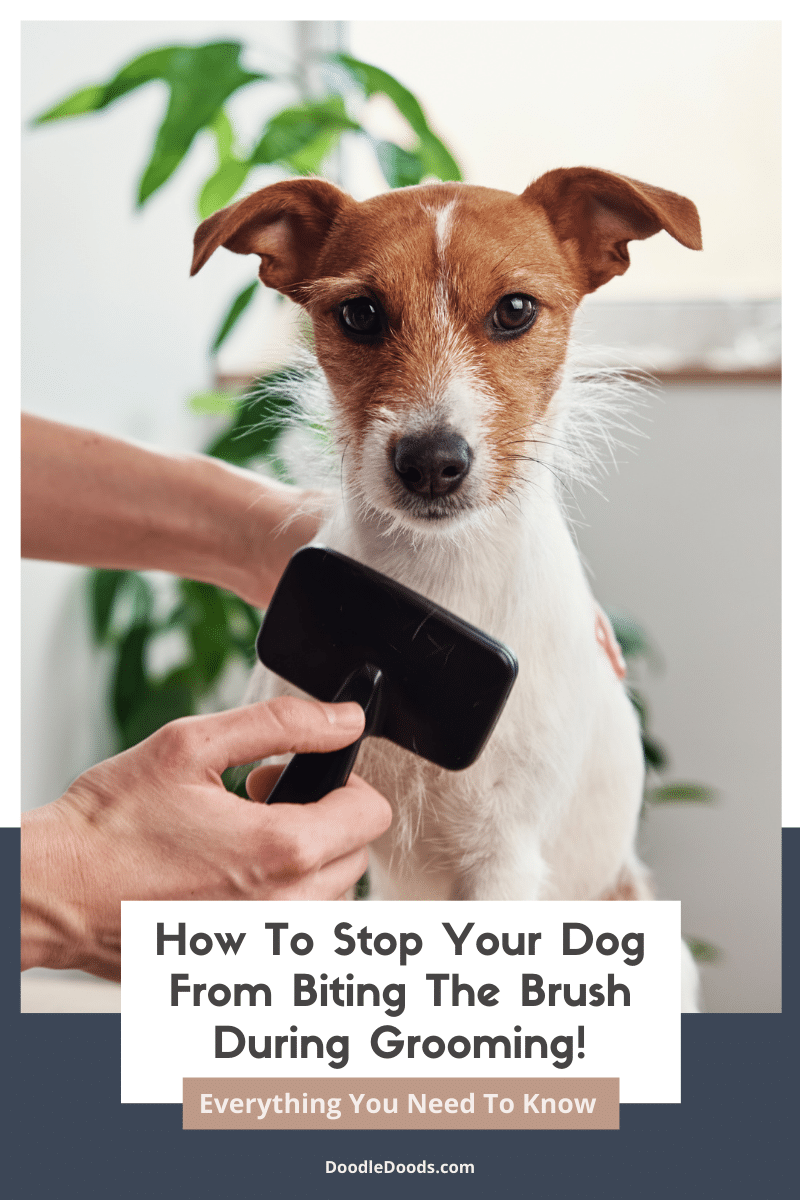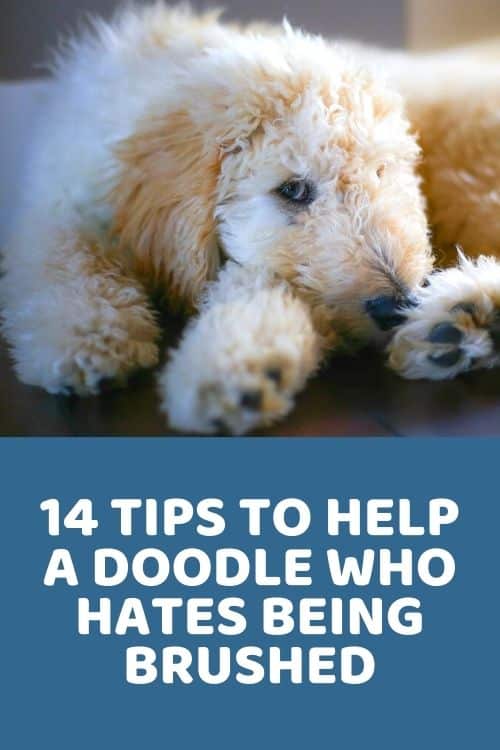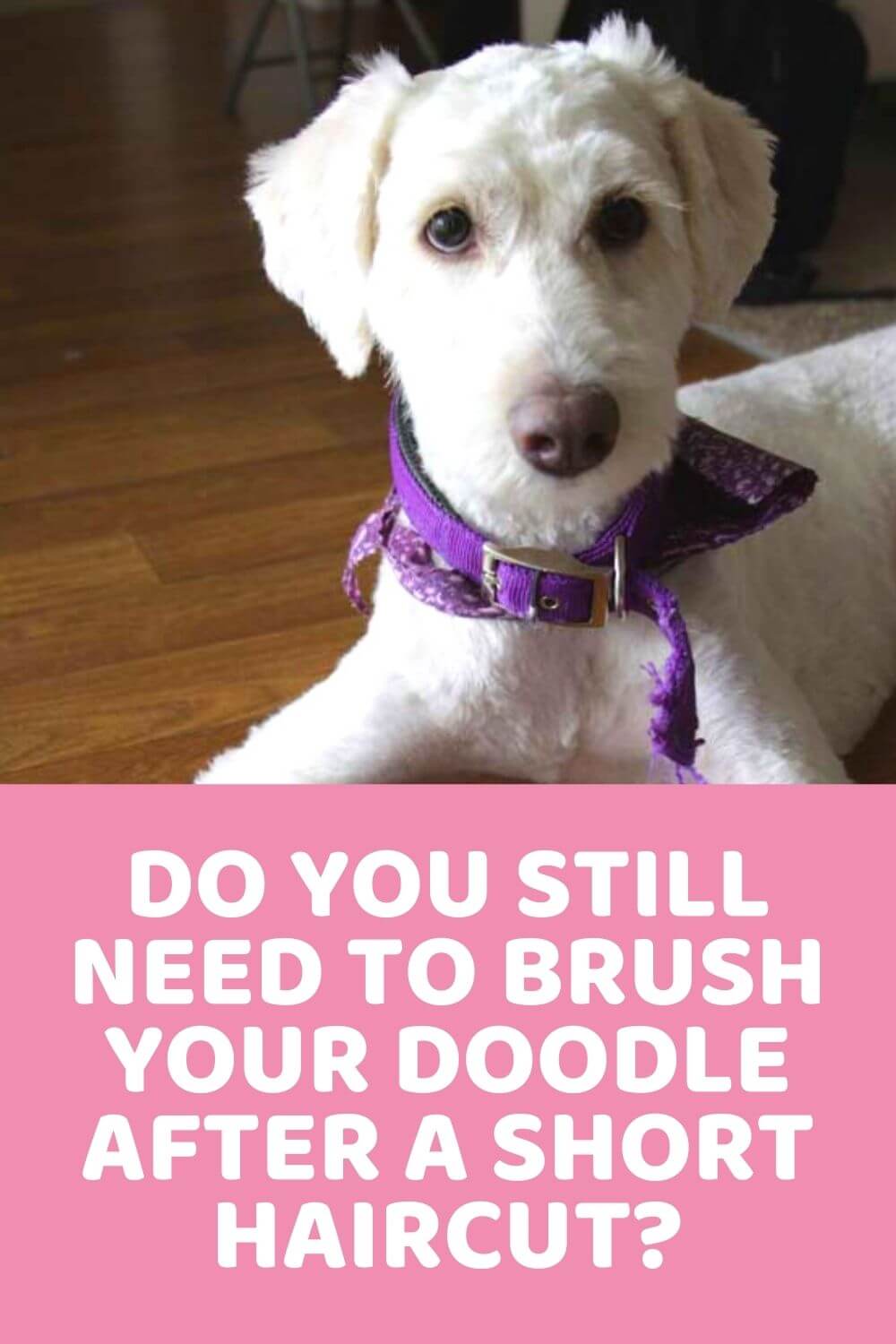Grooming is an important topic for all dog owners, but especially if you’ve got a Doodle pup. What many of us struggle with is the actual process of grooming. In fact, it’s not all that uncommon for a puppy or an adult dog to be biting the brush while you’re grooming them. In this guide, we’ll talk about why dogs behave this way and how to stop your dog from biting the brush. Let’s get into it!
Table of Contents
- How To Stop Your Dog From Biting The Brush: Introduction
- Why Does My Dog Keep Biting The Brush?
- Watch For These Signs To Spot Discomfort While Grooming
- Importance Of Grooming Your Dog
- How Do I Make My Dog Comfortable With A Brush?
- How To Stop Your Dog From Biting The Brush: FAQs
- How To Stop Your Dog From Biting The Brush: Conclusion
How To Stop Your Dog From Biting The Brush: Introduction
If you’ve got one of those high-maintenance dogs like a Doodle or perhaps some purebred who requires frequent grooming sessions, you’d naturally want those sessions to go about with minimal fuss. While it’s easy for us to simply purchase the right kind of grooming tools and get grooming, our doggos might have a bit of a different thought process behind it.
Even puppies that have been introduced to grooming tools and the process of grooming from a young age can have an issue with it even after lengthy periods of time. But even if your dog completely hates being brushed, or just doesn’t know how to *behave* whilst you’re brushing them, this isn’t an excuse to neglect your pup’s health and wellbeing and stop grooming altogether.
If your pup is one of those unlucky ones who just isn’t too keen on being groomed, there are fortunately quite a few things how you can make this process a more enjoyable one for the both of you. And that’s what we’ll help you figure out in today’s guide.
Why Does My Dog Keep Biting The Brush?
If your dog is biting the brush whenever you try to groom them, there could be a few possible reasons for that behavior. In some cases, it’s simply due to them seeing it as play – your pooch is just so playful they can’t contain themselves! However, it could also indicate that your dog is feeling discomfort or pain during grooming. Or perhaps they fear the brush or the grooming sessions.
The latter can also happen if your dog has been hurt during grooming in the past. This is an especially big concern for dogs who have been seriously traumatized or abused earlier in life. This is a common issue in dogs who come from rescues. But that’s not to say there’s anything wrong with them. They just need a bit more of your encouragement and guidance, and for you to be mindful of their difficult past.
Even if you’ve adopted your puppy from a reputable breeder, a few painful grooming sessions could make them wary of all the next times they need to be groomed. None of us like to feel pain and discomfort, and dogs are no different in this area. For pups with sensitive skin, applying too much pressure onto the skin with the brush can be very uncomfortable and even painful. If this makes their skin itchy, it could even lead to injuries due to them trying to soothe the discomfort by scratching, licking, and gnawing on the skin.
When talking about puppies, we’ve got to remember how interesting and new everything is to them. So, they might see the brush as something extremely fascinating to inspect with their razor sharp teeth. Puppies, and even adult dogs can also get a bit impatient in the process. They want to be moving around and they might not exactly be in the mood of sitting still and being touched by a brush over and over again.
Watch For These Signs To Spot Discomfort While Grooming
If you’re not exactly sure why your dog is biting the brush during grooming, it’s wise to keep your eyes peeled for certain signs and symptoms. This helps you identify whether this behavior is triggered by pain and discomfort, or if your pup is actually feeling playful and can’t keep the brush out of its jaws.
If your dog is feeling discomfort during grooming, the symptoms can include:
- Growling and whining
- Lip curl
- Cowering
- Whale eyes
- Tucked tail
- Tense body
- Flattened ears
- Aggressive bites
On the other hand, if your pup is feeling cheeky and playful, they’ll show signs like:
- Excitable barking
- Relaxed body
- High, waggy tail
- Leaping and wiggling
- Playful “smile” and bites
If your pup is simply impatient, they may try to wiggle out of your arms. However, they may also try to escape your arms whenever they’re feeling threatened, fearful, or even just being silly. So, it’s important that you learn to understand your dog’s behavior and body language to differentiate how they’re feeling. Then, you can start taking appropriate steps to make your dog more comfortable with grooming.
Importance Of Grooming Your Dog
Regular grooming is an absolute necessity for many purebreds and hybrid breeds like Poodle mixes. If you’ve got a high-maintenance dog that requires lots of grooming, it’s essential for preventing matting and minimizing shedding. But it’s so much more than just how your dog’s coat looks like. Yes, a matted and pelted coat will look very dull and unkempt. However, it’s also very uncomfortable for your dog. It can get very itchy and painful if those hair strands get pulled by the knots.
This in turn will lead to skin irritations and ultimately lead to hot spots that can get seriously infected. If those infected spots aren’t treated properly, they can get infested with maggots. Additionally, matted dog hair often also hides flea and parasite infestations, which also contribute to other skin problems. In severe cases, mats can start to grow around a dog’s leg so that the blood supply cuts off. In some cases, it’s possible to treat it, but in other cases, the only solution might be amputation.
Now, it’s clearly necessary that you regularly groom your dog if you’ve got one of the high-maintenance breeds. Not just for your dog’s looks, but their actual health and wellbeing. But another thing you should keep in mind is that the more you put off grooming your dog and let the mats form, the more painful the next grooming session will be. Unless, of course, the only option is to shave their whole coat off. So, if you don’t want to torture your dog with no reason and ensure that they’re comfortable around a dog brush, be sure to groom them on a regular basis.
Word Of Caution For Future Pup Parents
To be fair, we always, always, always recommend you to do extensive research before adopting a dog. You need to understand what their grooming and coat care requirements are. This will dictate how much time you’ll have to spend on grooming on a daily, weekly, and monthly basis. For breeds like the Poodle, Bichon Frise, Portuguese Water Dog, or Doodle breeds, to name a few, it’s an integral part of their maintenance routine.
If you don’t know how you could fit in time for daily grooming activities, or know yourself to not be disciplined enough to commit to it, we strongly advise you to look into breeds that don’t require much grooming at all. After all, as a dog owner, it’s wholly your responsibility to not neglect your dog’s health and wellbeing.
How Do I Make My Dog Comfortable With A Brush?
Start While Your Dog Is Young
With dogs, prevention is always better than cure. To prevent your dog from biting the brush every time you groom them, the best course of action is to introduce your pup to grooming tools and body handling as soon as possible.
If you’re adopting a young puppy from a breeder, then rest assured, all ethical breeders will start body handling and desensitizing their pups to grooming in their care already. It’s best to keep up with this at home so that your dog can properly get accustomed to it by the time they become an adult.
You can start by touching your pup’s tail, paws, and also their toes with your fingers. Gently massage their ears, and so forth. All of this will help your puppy get used to grooming later on with proper tools.
If you’ve got an older pup, gently touching them in different areas will also help them get used to body handling. But be sure to reward them with treats and praise in the process. If they get really anxious and stressed out, you can help them with certain desensitization and counter-conditioning techniques as well. Keep in mind that some areas on a dog’s body can be more triggering, so be extra mindful with that and remember what those areas are.
Make The Grooming Sesh Comfy And Relaxing
An easy, yet helpful tacting to stop your dog from biting the brush is to make the grooming sessions as comfortable and relaxing as possible for your little furbaby. Place your dog on something soft and cushy so that they’re comfortable sitting still. A blanket or a plush towel often does the trick.
If your pooch is biting the brush when feeling playful, it could help to schedule the grooming sessions when your pup is calmer and more relaxed. Have them exercise beforehand and be sure to play with your dog utilizing fun toys and activities. If you tire out your dog, they’re more likely to sit still during grooming.
If you’ve got a more anxious dog, you can also give them calming treats or CBD oils. This will help soothe and relax your pup.
Let Your Dog Sniff And Inspect The Grooming Tools
One of the best ways to get your dog to stop biting the brush is to help them get used to being around grooming tools. Before you start grooming your pooch, set up your dog grooming tools and let your dog inspect them in any way they’d like to, such as smelling, touching, or biting..
As you might know, dogs explore the world through all of their senses, including their mouths. So, when you let your pup sniff the brush and comb, they might want to get in a little nibble of it, too. This way, they won’t be overly keen on biting the brush during grooming.
Don’t Forget The Treats And Toys
Treats and toys are an excellent way to create a positive association with grooming. After all, dogs are often motivated by food and they certainly respond best to positive reinforcement. So, always have plenty of yummy dog treats at hand to feed your pup, especially as you’re starting out.
For instance, if you’re just introducing the grooming tools to your pet, calmly reward them with praise and treats for inspecting the tools. And then again reward them for letting you touch them or brushing them. The earlier you are in the process, the more treats you’ll have to feed for your dog. But the more they get used to being groomed, you can start increasing the time between giving them treats.
For more rambunctious pups that can’t seem to sit still or take grooming sessions as play time, we recommend redirecting their attention away from the grooming brush onto something way more exciting. Lick mats and treat dispensing toys are perfect for that. But this can also work for more anxious dogs that need to be busy with something else during grooming.
Keep The Grooming Sessions Short
If you’ve got your hands full with a dog that’s biting the brush every time you try to groom them, it would be wise to cut those grooming sessions short. The shorter the sessions, at least initially, the better. As soon as you notice your dog getting overwhelmed, take a break. If they’re not feeling comfortable at all, let them leave.
You can start gradually increasing the grooming sessions once you see that your dog is getting more comfortable with being brushed. For playful pups, this will likely take a bit less time than for dogs who are more stressed and anxious.
Choose The Right Brush
You might be wondering – what is the best brush for a dog who hates being brushed? Well, regardless of how well your dog tolerates being brushed, you should choose one that’s the most effective according to your dog’s coat type and grooming needs.
For Poodles and Doodles, the best brushes are slicker brushes. However, some pups may have some difficulty at first getting used to being brushed by such a bulky tool. Gradually letting your pup get used to the grooming tools will certainly help with that.
Soft bristle brushes are excellent for dogs with sensitive skin. However, a bristle brush isn’t as effective as a pin brush or a slicker brush. So, a bristle brush would be more suited for short-haired breeds that don’t get very easily matted. You can also use a bristle brush or a soft puppy brush on a young puppy who hasn’t shed its puppy coat just yet.
Dogs and puppies both have very sensitive skin, but especially puppies – they’re technically still babies! So, it’s all the more important to start with very soft brushes that won’t create any negative associations while your pup is still young.
Talk To A Professional Dog Groomer Or Your Veterinarian
Talking to a professional dog groomer or your dog’s vet can be very helpful if you’re at your wits end. Great groomers tend to handle more anxious and even aggressive pups extremely well and they might be able to give you some excellent tips for stopping your dog from biting the brush at home as well.
On the other hand, if in between your at-home grooming sessions you have your dog also groomed at a grooming salon, make sure to let them know how you usually go about it. Indeed, you might have a wonderful groomer who can calm down even the most anxious pup during the grooming sessions. However, if your pup also struggles with professional groomers, discuss with the groomer how you usually soothe and reward your dog during grooming. This way, there won’t be new negative associations for your dog whenever they get groomed by someone else.
Your vet may also be able to share with you some tips and tricks on how to get your dog used to grooming. You can ask them for advice about specific calming treats and CBD oils to ensure that they’re safe for your pup. If your dog is very anxious, they might prescribe calming medications instead. In certain cases, your best option might be to use a dog muzzle during grooming sessions.
Stay Calm And Never Punish Your Dog
Needless to say, you should never make loud noises or aggressive movements when brushing your dog. Yes, they may snap or have difficulty sitting still, but that’s not an excuse to scold your pet or punish them. You should only use positive reinforcement to not create any more negative associations for your pooch. Always speak to your bet in a calm and encouraging tone, making them feel safe and secure in your presence.
How To Stop Your Dog From Biting The Brush: FAQs
The best brush for a dog that doesn’t like to be brushed is something super effective and high-quality, such as a slicker brush or a pin brush. You want a dog grooming brush that’ll help you get the job done effectively and fast so that those grooming sessions will be short and sweet. Oftentimes, the quality and price point of a dog brush do go hand in hand, so you might want to steer clear from the cheapest and flimsiest of brushes you can find. Some of our favorite brushes for grooming Doodles, a.k.a very heavy-duty and effective brushes are from the brand Chris Christensen. If you have a short-haired and smooth-coated breed that isn’t prone to matting, you can use a bristle brush. Bristle brushes have very soft bristles so they’re less likely to irritate pups with sensitive skin.
Your goal is to gradually let your dog get used to body handling and grooming tools. The earlier you can start gently touching your pup’s paws, ears, and other areas, the better. For older dogs, be sure to also incorporate treats, especially if they’ve been traumatized in the past. Then, you’ll also want to make your puppy or dog feel comfortable around the grooming tools you’ll be using. Let your dog sniff and inspect the tools whilst you give them praise and some tasty treats.
After the first successful steps, you can start brushing smaller areas at a time and again rewarding your dog in the process. Keep the grooming sessions as short as possible, only gradually increasing the length over time as your dog gets more comfortable being groomed. If you’ve got a very anxious or fearful dog, you might find help from calming treats or certain medications – only under the guidance of your veterinarian!
How To Stop Your Dog From Biting The Brush: Conclusion
Dogs need to be groomed, some more often, some less. But getting them used to being groomed is a common issue that many of us struggle with. We hope this guide has given you some helpful insights on how to stop your dog from biting the brush, whether it’s due to them being playful or feeling anxious. The main thing is that you stay calm, patient, and consistent, and soon both you and your pup won’t be dreading those mandatory grooming sessions anymore!
Want to Learn
DIY Doodle Grooming?

 “Every concern and question I had now has clear, practical solutions.” – Paula D.
“Every concern and question I had now has clear, practical solutions.” – Paula D.
 “These lessons have provided tremendous amounts of information.” – Steve B.
“These lessons have provided tremendous amounts of information.” – Steve B.
 “Buy the course and complain about how easy it is!” – Chris S.
“Buy the course and complain about how easy it is!” – Chris S.
Learn How To Groom Your Doodle At Home…
Safely…And Without Confusion:




